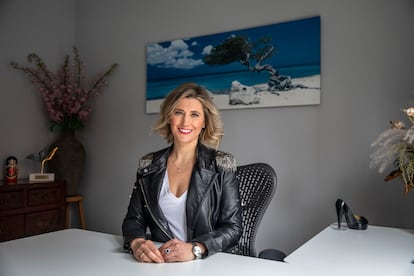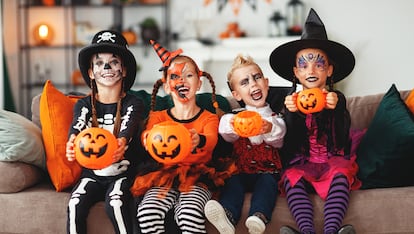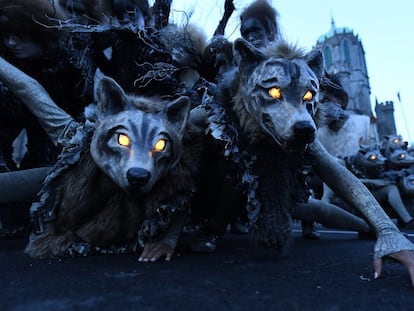Silvia Álava, psychologist: ‘We are very hypocritical; we celebrate Halloween and dress up, but we don’t talk about death’
Wearing a disguise fosters the imagination, creativity and empathy of the children. This time of year is a great opportunity to do it, always taking their tastes and wishes into account, and explaining the meaning of the celebration

Witches. Spiders. Ghosts. Jack-o’-lanterns. Halloween is right around the corner. It’s a very exciting day for many children, who will get to dress up and collect fistfuls of candy. But how well do they know the meaning of this celebration? Child psychologist and author Silvia Álava Sordo believes that its main purpose – that grandparents, parents and children spend some time with nostalgia and death – is fading away.
“I think we are very hypocritical, because we celebrate this day and dress up, but we don’t talk about death with the children,” says Álava. “It’s not just that day. There are parents who are incapable of dealing with death, who keep their children away from hospitals and funeral homes – even from illness. This is wrong because death is a part of life, and this day can be a good opportunity to remember those who are no longer here,” she adds.
Álava believes that it is a good idea to teach children that, aside from all the fun of dressing up and having a great time with their friends, there are places like Spain and Mexico where people spend that time of the year remembering those who have died. “Perhaps it’s a good moment, for example, to remember the grandfather who passed away this year, to look at his photos together and tell stories about his life. Not from a place of sadness, but from nostalgia. Letting them know that, although we obviously miss him, we’re grateful for the time we spent with him.”
What should they dress up as?
As October 31 approaches (and many tend to start the celebrations earlier), children get increasingly excited about the day when they will become vampires, witches or mummies. Regarding the costumes they should choose, Álava Sordo says the main thing to avoid is masks, especially if they are young: “It’s not only that you can’t see their faces, but also that it can overwhelm them and impair their breathing.” What’s more, some minors could be afraid to go as vampires, witches or skeletons: “The best thing in these situations is to talk to them about the playful side of Halloween [...] such as the costumes, the jack-o’-lanterns or the trick-or-treating, and ask them if they understand, and how they want to participate. Maybe they want to go as something else. And that’s fine, too.”

Around this time, there is often a parental debate about whether it is better to buy a costume or to make it at home. “In my opinion, it’s better to do it yourself,” says Álava. She is not talking about the parents sewing away at night; she means organizing a family activity, involving the children and being creative. “We can simply take cardboard, rubber bands, things we have at home, and make it together bit by bit.” The psychologist emphasizes that the point is not to win a contest, but to do something fun, even if the result is not as spectacular as a costume you could purchase at a store. “In addition, with activities like these you teach teamwork, and the child will feel much more involved.”
Of course, in school there must be a consensus between store-bought and homemade costumes. “There may be a boy or a girl in the classroom whose family cannot afford it. It is essential to be aware of each minor’s personal situation, so that the teacher can praise the effort and creativity of the child and their family. And, above all, it is not about who has the best costume – it is a moment of group cohesion, to have fun, a day in which we do different things.”
Normally, and especially in early childhood education, there is a tendency for teachers to choose a theme for the costume, such as witches, vampires and spiders. Álava points out that it is important for teachers to take into account the tastes of their students, and to choose something they can understand: “A good idea would be for everyone to go as animals, as easily identifiable professions or, in the case of Halloween, maybe mummies or witches. What could a child not understand? If they all go as people from the 1980s, for example, or from a specific horror movie.” In addition, teachers should be sympathetic when a child comes to class with something different from what was originally planned: “It’s OK. We still have fun.”
“Some children love to dress up, but others don’t,” she continues. “In these situations you have to respect their opinion, you have to understand that they don’t want to do it.” In conclusion, you do not have to force or convince them to do it. In these cases, Álava adds, what is best is to explain to the minor what they will find when they arrive at school that day. “You have to tell them that everyone is going to be in disguise except for them, and that they may have to answer questions from their peers or the school community. You also have to warn them that they may feel a little weird being the only one that is different.” You can propose to buy or make a costume together the previous days, so they have something to wear if they change their mind, or even put it in their backpack, just in case – “with their permission, of course. You have to let them know.”
The benefits of dressing up
“Parents should know that wearing a disguise is more than just a child dressing up as their favorite character at a party or during Halloween. They are role-playing, it’s a game. And I’m not just talking about store-bought outfits; the child does it at any time of the year, for no reason, and with anything. They can use paper, rags, cloth, or their parents’ clothes. Anything goes.” And the benefits are many.
As the expert explains, this type of symbolic play – a spontaneous activity in which children use their mental ability to recreate a scenario for entertainment – fosters creativity, imagination and empathy. “Sometimes it’s not easy to understand the feelings of others, and costumes can help children comprehend unfamiliar situations; they help them create and experience different characters and, on top of that, they have a good time while they do it.”
Tu suscripción se está usando en otro dispositivo
¿Quieres añadir otro usuario a tu suscripción?
Si continúas leyendo en este dispositivo, no se podrá leer en el otro.
FlechaTu suscripción se está usando en otro dispositivo y solo puedes acceder a EL PAÍS desde un dispositivo a la vez.
Si quieres compartir tu cuenta, cambia tu suscripción a la modalidad Premium, así podrás añadir otro usuario. Cada uno accederá con su propia cuenta de email, lo que os permitirá personalizar vuestra experiencia en EL PAÍS.
¿Tienes una suscripción de empresa? Accede aquí para contratar más cuentas.
En el caso de no saber quién está usando tu cuenta, te recomendamos cambiar tu contraseña aquí.
Si decides continuar compartiendo tu cuenta, este mensaje se mostrará en tu dispositivo y en el de la otra persona que está usando tu cuenta de forma indefinida, afectando a tu experiencia de lectura. Puedes consultar aquí los términos y condiciones de la suscripción digital.
More information
Archived In
Últimas noticias
AfD, a key pawn for Trump in Europe, strengthens ties with Washington
From cook to sniper: Ukrainian women fight for equality in the army
Trump succeeds in increasing deportations by hiring military personnel to act as judges
More than 40 Democratic lawmakers urge Trump in a letter to stop his ‘attempts to undermine democracy in Brazil’
Most viewed
- Christian Louboutin: ‘Young people don’t want to be like their parents. And if their parents wear sneakers, they’re going to look for something else’
- Cartels in Mexico take a leap forward with narco-drones: ‘It is criminal groups that are leading the innovation race’
- ‘El Limones’ and the growing union disguise of Mexican organized crime
- Liset Menéndez de la Prida, neuroscientist: ‘It’s not normal to constantly seek pleasure; it’s important to be bored, to be calm’
- The low-cost creative revolution: How technology is making art accessible to everyone











































